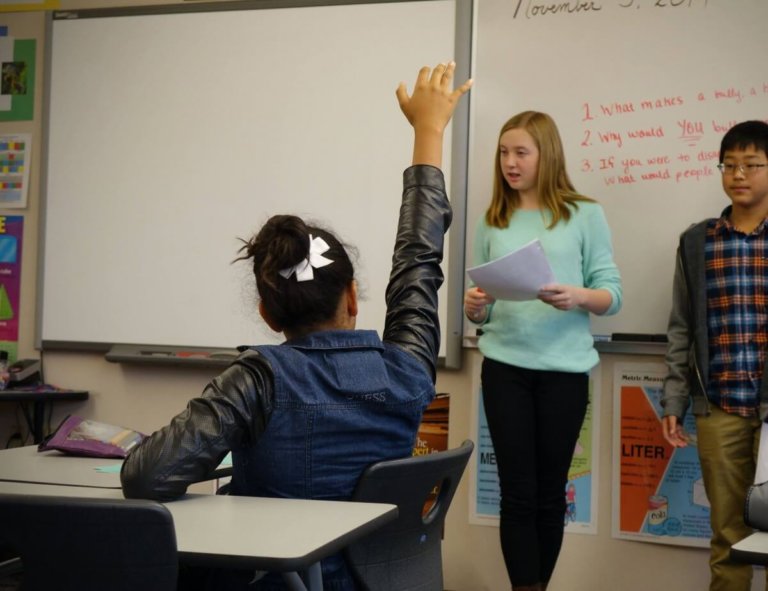“Okay, next question,” says Middle School student Ella Bittman in front of the whiteboard in her advisory class. She pops the top to the dry-erase marker open and closed as she prods further, emphasizing the point of her query, “Why would you bully someone?” she asks.
Students casually raise their hands doling out slow answers in the informal setting. “If they were mean to me and teased me and made fun of me,” says one, “then I might bully someone.” Says another, “Maybe because you don’t feel confident or good about yourself and want to make others feel the same way.”
The question follows another on the topic of bullying written on the board: What makes a bully, a bully? It’s the theme for the program led in Middle School advisory class by the Student Leadership Team, a group of selected Middle School students who meet every “C” day to have training sessions and discuss ways they can impact the school.
The Leadership Team completely created the three-part program—its talking points and activities—during one of those training sessions in honor of anti-bullying month, which was in October. Says Middle School Counselor Kate Van Cott, who helped organize the discussions, “They created the program to address why a bully might act this way, and why you might resort to bullying. These activities and discussions bring awareness to the impact bullying has on individuals. They also help students take ownership of times they have been bullied or have bullied others in the past.”
“But what if you wouldn’t bully someone?” asks seventh grader Kennedy Massey sitting in the front row of her advisory class. Snapping the cap closed on the dry erase marker, Bittman considers the question before answering. “Well, we’ve all bullied someone at some point, haven’t we?”
“They created the program to address why a bully might act this way, and why you might resort to bullying. These activities and discussions bring awareness to the impact bullying has on individuals. They also help students take ownership of times they have been bullied or have bullied others in the past.”
The statement shows a unique self-awareness for a Middle School student. And for the most part, Bittman is right. According to StopBullying.gov, approximately 30 percent of young people admit to bullying others. As to why it’s so important to discuss the issue in schools, the same survey found that most bullying takes place on school grounds and on the bus, particularly affecting those in Middle School.
Using an activity, the students demonstrate why this type of intimidating behavior can be so dangerous. They outline a person’s body on a piece of paper, write insults inside the figure and then crumple the paper in order to show how these types of comments can destroy someone’s self image and lead to defeated body language in the victim.
“The overall idea,” says Van Cott, “is to bring awareness to how these actions can play out among Middle School aged students and what each person can do to prevent it.” Which leads to the last question Bittman writes on the board:
“If you were to leave CA today, what would you want to be remembered as?”
The students answer amongst themselves, filling the classroom with lively chatter as Bittman adds that it’s something they should think about in the coming week and be ready to discuss during their next meeting. After the advisory period, fellow student leader Makayla Sileo says that while bullying isn’t a big issue at CA, these programs help to keep it that way.
“I feel that we all need to have an awareness of this because it does goes on,” Sileo says. “If we have an awareness, then we’ll be able to build our community and a stronger bond. That way, we won’t have those negative friendships.”
